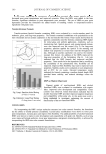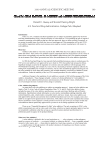18-MEA AND HAIR APPEARANCE 153 70°. It was very interesting that the surface of the hair maintained some degree of hydro- phobicity even after removal of most of the 18-MEA. The receding contact angle, on the other hand, decreased in a linear manner from 80° to 0° as the relative ion yield of 18-MEA versus the CN ion yield decreased to 0. The correlation coeffi cient (R) and p-value (p) for the slope of the regression line were also obtained. R was 0.92 and p was 4.0 × 10−99 (n=237). A strong correlation between the receding contact angle and the relative ion yield of 18-MEA versus the CN ion yield was observed. The slope of the line for the re- ceding contact angle, 251.96, was 4.3 times larger than that of the advancing contact angle, 58.31. The results indicate that the decrease in 18-MEA on the cuticle surface af- fects the fi bers more in going from a wet to a dry environment than in going from a dry to a wet environment. In order to investigate the role of 18-MEA on the surface friction in the wet state, three hair fi bers, hair A, hair B, and hair C (Figure 6), were selected, and friction force micros- copy was performed. The surface properties of hair A, hair B, and hair C, are listed in Table I. In the FFM study, an unmodifi ed silicon nitride (Si-N) AFM tip was used. The unmodifi ed silicone nitride AFM tip (21) and hair surface are both hydrophilic in the wet state, although the components of these substances are different. It was hypothesized that the interaction between the AFM tip and the hair surface in the wet environment could thus correspond to the interaction between one hair fi ber and another in the wet environment. To characterize friction properties, 2 μm × 2 μm scans of the cuticle surface (avoiding the edges) of the cuticle were performed. Figure 7 shows the typical FFM images for hair A, hair B, and hair C in water at 2-μm × 2-μm scan size. Darker areas represent the friction force as being lower, and brighter areas represent the friction force as being higher. The average values of the friction force for hair A, hair B, and hair C are shown in Figure 8. The bars represent means for n=6 areas of each fi ber, and the whiskers represent the standard deviations. The asterisk symbol indicates the p-value obtained from analysis of variance (ANOVA). The relative ion yield indicated that most of the 18-MEA was removed for hair C and that it gave the highest friction value. The Table I Relative Ion Yield of 18-MEA vs the CN Ion Yield and Dynamic Contact Angles of Hair Hair A Hair B Hair C Relative ion yield of 18-MEA vs the CN ion yield 0.27 0.10 0.00 Contact angles Advancing 121.4° 113.3° 99.5° Receding 65.1° 33.7° 6.1° Figure 7. Typical FFM images for hair in water at 2-μm × 2-μm scan size. Darker areas represent a lower friction force and brighter areas represent a higher friction force.
JOURNAL OF COSMETIC SCIENCE 154 results of ANOVA showed that there was a signifi cant difference in the friction force between hair A and hair C. That means the decrease in 18-MEA led to an increase in the friction force in the wet state. A decrease in 18-MEA also led to a decrease in the receding contact angle and an increase in friction force. One can picture the high frictional force as the strong adhesive force that causes the fi ber aggregation. The combination of the decrease in the receding contact angle and the increase in the friction force in the wet environment should affect hair alignment in the wet state and make the hair fi bers entangle more readily in the wet state. Since some of the hair fi bers examined here experienced a variety of damage, such as chemical damage, mechanical damage, and heat and sunlight, a lot of structural changes were observed on the surface of the hair: scale lifting, broken cuticle scale edges, removal of cuticle, and so on. It seemed diffi cult to identify the role of 18-MEA itself on hair alignment with these fi bers. In order to determine the role of 18-MEA on hair alignment, 18-MEA-removed hair was prepared using chemically untreated hair, and it was investi- gated for the effects of the removal of 18-MEA on hair alignment. ROLES OF 18-MEA ON HAIR APPEARANCE It was necessary to check that the treatment by which 18-MEA is removed does not affect the physical properties of the hair fi ber, except for the surface properties, since the aim of the present study was to determine the role of 18-MEA itself on hair alignment. Scanning electron microscopy (SEM) images of the hair surface, the diametric swelling ratio in water, the elastic modulus in water, and the breaking stress in water for chemically un- treated hair and 18-MEA-removed hair were analyzed for this purpose (Table II). There were no signifi cant differences in the SEM images between the untreated hair and 18- MEA-removed hair. There were also no signifi cant differences in the diametric swelling ratio in water, the elastic modulus, and the breaking stress between the untreated hair and the 18-MEA-removed hair by Student’s t-test. It was confi rmed that the removal of 18- MEA did not change these properties, and therefore we concluded that this 18-MEA re- moval treatment affected only the fi ber surface. The relative ion yield of 18-MEA versus the CN ion yield on the outermost surface of hair and the contact angles for untreated hair and 18-MEA-removed hair are listed in Table III. The relative ion yield of 18-MEA versus the CN ion yield for untreated hair and Figure 8. Friction forces for (a) hair A, (b) hair B, and (c) hair C in water. The bars represent means for n=6 areas of each fi ber the whiskers represent the standard deviations. The asterisk symbol indicates the p-value obtained from analysis of variance (ANOVA) **p 0.01.
Purchased for the exclusive use of nofirst nolast (unknown) From: SCC Media Library & Resource Center (library.scconline.org)





































































































































